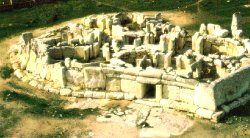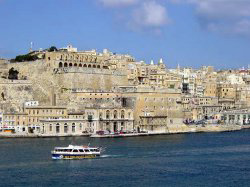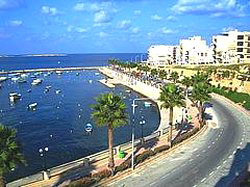November 28th, 2007
Malta: Fascination Unlimited
Malta, as in "Maltese"
The Maltese Falcon: Movie fans are familiar with the �Maltese Falcon� which starred Humphrey Bogart, and a little bird from Malta. Legend has it that in 1539, the Knights Templar of Malta paid tribute to Charles V of Spain by sending him a Golden Falcon encrusted from beak to claw with rarest jewels -- but pirates seized the galley carrying this priceless token and the fate of the Maltese Falcon remains a mystery to this day.

Malta's history goes back 7000 years. These are the ruins of Hagar Qim, some of which are believed to pre-date the Pyramids by 1000 years. Photo Malta.com
|
The legend was probably based on the fact that Malta was leased to the Knights by Emperor Charles V of Spain for a rental of one real Falcon per annum.
The Maltese Cross: Originally the symbol of Amalfi, a small Italian republic of the 11th century,
the Maltese cross is an eight point cross of an order of Christian warriors known as the Knights of St. John of Jerusalem, Rhodes and Malta. Its design is based on crosses used since the First Crusade. The eight points are said to symbolize the eight knightly virtues.
Malta as an archipelago
Malta is a small archipelago of 316 sq km (roughly twice the area of Washington, D.C.).
It consists of three main inhabited islands; Malta, Gozo and Comino. Malta became formally recognized under British Dominion in 1814 after the Treaty of Paris. Previously, the Maltese asked the British to help expel the French, which Sir Alexander Ball and the British Fleet did in 1800 after much international political maneuvering.

Despite the heavy bombing during WWII, Valletta is still a beautiful city with many palaces, houses and churches. Photo Malta.com
|
The French, directed by Napoleon, had captured the islands from the Knights of Malta in June 1798. In 1942, in an attempt to capture the strategically placed islands, the Germans and Italians dropped more bombs on Malta than on London. In less than one year, during 1941/42, 13,750 tons of bombs were dropped, killing 1 in 70 of the population. But the Maltese citizens never surrendered, and in 1942, The People of Malta were awarded the George Cross by King George VI for their gallantry, a gesture never made before to an entire nation. Malta became a republic in 1964 and today is an EU member.
History
Malta has been inhabited for over 7000 years, since Neolithic times, and enjoys the status of having some of the world�s oldest buildings. Around 2000 BC the island was conquered by the Phoenicians, Carthaginians and then the Romans. St. Paul founded Christianity there in AD 60 after being shipwrecked en route to Rome.

St. Paul wouldn't recognize it, but this bay is where he landed in 60 AD and founded Christianity on the island. Photo Malta.com
|
In AD 870, Malta was conquered by the Arabs. Norman Sicilians took Malta from the Arabs in 1090. Christianity was reestablished and the conquerors remained until 1530. During the next 268 years the Knights of St. John ruled the Maltese Islands until Napoleon occupied the island in 1798.
Malta Today
The current population of Malta is 401,880. Many Maltese are descendents of ancient Carthaginians and Phoenicians, along with elements of Italian and other Mediterranean countries. The official language is both English and Maltese. The economy is based on electronics manufacturing, offshore investment, IT, pharmaceuticals, tourism and its ship repair facilities and dockyards.
For more information, go to
Malta.com.
|



